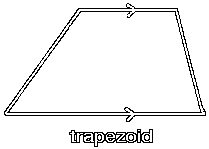
If AP = 8 and EQ = 28, then how long are and ? Problem: Suppose parallel lines l, m, n, and p cut so that segments, ,, and all have the same length: This result can be repeated as in the following example: If an angle is cut by two parallel lines so that the pairs of segments on one side of the angle are equal, then the pairs of segments on the other side of the angle will be equal and the segment on the parallel between the vertex of the angle and the other parallel is half as long as the segment on the other parallel: Ĭonsequences of the Triangle Midsegment Theoremįrom the Triangle Midsegment Theorem it follows that a segment joining the midpoints of two sides of a triangle is parallel to the third side and half its length, since there can be only one line through a given point (the midpoint of one side) parallel to another line (the third side).Īnother way to state the Triangle Midsegment Theorem is:
#PARALLEL SIDES PC#
Likewise, since AP and PC are both equal to MN, P is the Since BN and NC are both equal to MP, they are equal to each other, so N is the midpoint of. Thus, MNCP is a parallelogram, and by Example 3 from the previous lesson, its opposite sides are equal: and : But these are corresponding angles for segments and with transversal, so by the Corresponding Angle Theorem. Also, since (this was given), because these are corresponding angles for the transversal. Therefore, these triangles are congruent by the SAS postulate, and so their other corresponding parts are congruent:, , and. Notice that is a transversal for parallel segments and, so the corresponding angles, and are congruent: First locate point P on side so, and construct segment : We will show that the result follows by proving two triangles congruent. Now we can prove the Triangle Midsegment Theorem: Given: Therefore and since these are corresponding parts of the congruent triangles. Thus by ASA since they have side in common. Then since opposite sides are parallel (this is the definition of a parallelogram), and since these are alternate interior angles for the parallel sides with transversal. Let the parallelogram be ABCD, and draw the diagonal. Theorem: The opposite sides of a parallelogram are congruent. Recall that a parallelogram is a quadrilateral with opposite sides congruent. In the case of the Triangle Midsegment Theorem, a preliminary result is that opposite sides of a parallelogram are congruent. To shorten proofs in geometry, we can sometimes prove preliminary results. (Two figures are said to be similar if they have the same shape, but not necessarily the same size.)Ī segment joining two sides of a triangle, parallel to the third side, and containing the midpoint of one of the two sides also contains the midpoint of the other side, and is half the length of the parallel side.

This result follows from a very important theorem, called the Triangle Midsegment Theorem, which also leads to results about similarity of figures.

If you draw any triangle, locate the midpoints of two sides, and draw a segment between these midpoints, it appears that this segment is parallel to the third side and half its length:


 0 kommentar(er)
0 kommentar(er)
